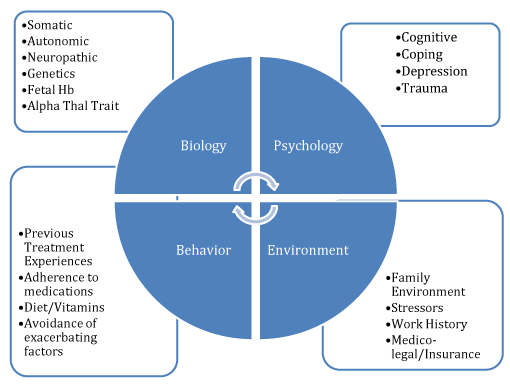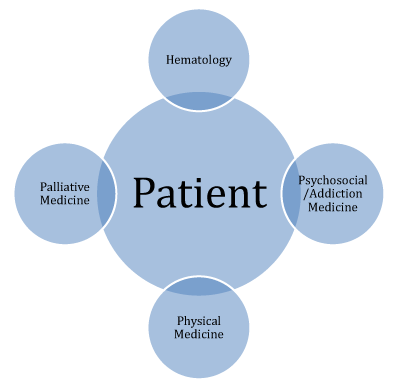Sickle cell disease (SCD) is the most common inherited hemoglobinopathy affecting ~100,000 people in the United States alone. Patients with SCD suffer many complications, including acute vaso-occlusive crises (VOC) and pain crises. These episodes of pain crises are a major reason for emergency room visits and admissions for pain control. Given the current opioid epidemic, treating pain in sickle cell crises presents a great challenge. Pain control in SCD is still not well understood, and patients can have their pain inadequately treated, sometimes as a result of medical team bias. This article discusses the current state of pain management amongst patients with SCD and the novel approach implemented at The Ohio State University Wexner Medical Center with a multidisciplinary clinic.
Major advancements have been made in SCD, with universal screening at birth, penicillin prophylaxis for pneumonia and scheduled vaccinations that have decreased pediatric mortality from SCD [1]. The transition into adulthood has been shown to be an important intervention point, as there is an increased risk of death within the first 5 years of transition [1]. There are multiple social, physiologic and psychosocial factors involved for which multidisciplinary care is important [2]. Primary care providers tend to assume full care of patients with SCD and this can impact care and pain control for patients who have a complicated disease [3,4]. Therefore, Crosby suggests a biopsychosocially-oriented, multidisciplinary model to help with the transition from pediatric to adult SCD care [2]. This idea plays a role in pain management for SCD pain crises.
The current landscape for pain management in SCD crises exists on a spectrum, from office visits to emergency department (ED) visits and hospital admissions. SCD pain is episodic but is also chronic and multidisciplinary [5]. Raphael and Oyeku previously discuss the current state of SCD pain management [5]. There are different categories: acute, chronic, neuropathic and mixed. This is where the idea of biopsychosocial care is highlighted, as there are multiple targets for intervention in pain control. Traditional models include non-pharmacologic and pharmacologic methods. Alternative therapies include guided imagery or heat packs [6]. The pharmacologic options consist of non-opioid agents (e.g., anti-inflammatories) and adjuvant therapies, like targeting neurotransmitters (e.g., antidepressants and antiepileptics). Opioids are used in more severe pain episodes [5]. However, opioid dosing is not always effective in pain crises, based on pharmacogenomics and perceived risk of addiction [7]. For example, a subset of patients with SCD are termed super-utilizers, who present to the ED more frequently because of more frequent pain episodes, and utilize more hospital and ED resources [8]. Simpson, et al developed an individualized care plan for super-utilizers, implementing a multidisciplinary team, and showed a decrease in ICU stay and mortality [9]. They also showed a decrease in ED and hospital utilization. Increased ED visits belie gaps in pain management, which include inadequate follow-up, poor communication between health care professionals and poor access to comprehensive SCD centers [10,5].
Given the complexity of pain management in patients with SCD, multidisciplinary approaches are required. At The Ohio State University Wexner Medical Center, a multidisciplinary approach for sickle cell treatment was created over the past 5 years. This includes coordination with a day hospital, outpatient clinic, emergency department, inpatient team, and as needed primary care, home visits. We approach the patient from not just the biologic perspective, but also evaluate the psychology, environment, and behavioral aspects of organic disease (Figure 1).

Figure 1. Multidisciplinary aspects of sickle cell disease management.
The patients struggling with pain control, particularly in the context of addiction, are seen in a multimodality clinic for sickle cell pain (Figure 2). This model accounts for the unique situation where patients require chronic pain control, but in the context of another life-limiting disease, addiction.

Figure 2. Model for Multi-disciplinary pain control in sickle cell disease.
SCD is a complicated disease process that requires a multidisciplinary approach to management. One of the main complications of SCD, pain crises, has already been shown to be a major burden on patients and the healthcare system. Through innovative models that incorporate multidisciplinary methods to addressing SCD and its complications, patient experience and quality of life can be dramatically improved.
Husain M: Co-author and performed literature review.
Desai P: Co-author, performed literature review, provided expert background on sickle cell disease.
Deborah Hanes, CNP, CNS & Saquena Atkins, LISW-S: co-contributor on Figure 1
Meredith Mucha, MD, FACP: co-contributor on Figure 2
The authors declare that there is no conflict of interest regarding the publication of this paper.
- Quinn CT, Rogers ZR, McCavit TL, Buchanan GR (2010) Improved survival of children and adolescents with sickle cell disease. Blood 115: 3447–3452. [Crossref]
- Crosby LE, Quinn CT, Kalinyak KA (2015) A Biopsychosocial Model for the Management of Patients With Sickle-Cell Disease Transitioning to Adult Medical Care. Adv Ther 32: 293–305. [Crossref]
- Okumura MJ, Heisler M, Davis MM, Cabana MD, Demonner S, et al. (2008) Comfort of general internists and general pediatricians in providing care for young adults with chronic illnesses of childhood. J Gen Intern Med 23: 1621-1627. [Crossref]
- Lottenberg R, Hassell KL (2005) An evidence-based approach to the treatment of adults with sickle cell disease. Hematology Am Soc Hematol Educ Program 2005: 58-65. [Crossref]
- Raphael JL, Oyeku SO (2013) Sickle cell disease pain management and the medical home. Hematology Am Soc Hematol Educ Program 2013: 433-438. [Crossref]
- Ballas SK (2011) Update on pain management in sickle cell disease. Hemoglobin 35: 520-529. [Crossref]
- Solomon LR (2008) Treatment and prevention of pain due to vaso-occlusive crises in adults with sickle cell disease: an educational void. Blood 111: 997-1003. [Crossref]
- Carroll CP, Haywood C, Lanzkron S (2011) Prediction of onset and course of high hospital utilization in sickle cell disease. J Hosp Med 6: 248-255. [Crossref]
- Simpson GG, Hahn HR, Powel AA, Leverence RR, Morris LA, et al. (2017) A Patient-Centered Emergency Department Management Strategy for Sickle-Cell Disease Super-Utilizers. West J Emerg Med 18: 335–339. [Crossref]
- Aljuburi G, Phekoo KJ, Okoye NO, Anie K, Green SA, et al. (2012) Patients’ views on improving sickle cell disease management in primary care: focus group discussion. JRSM Short Rep 3: 84. [Crossref]
2021 Copyright OAT. All rights reserv


